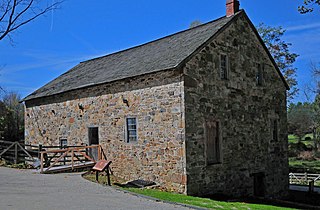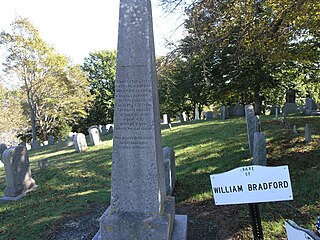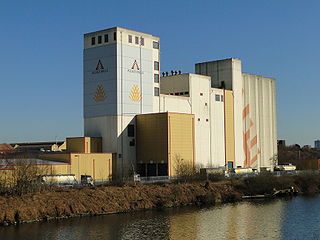
The Plimoth Grist Mill (formerly the Jenney Grist Mill) is a working grist mill located in Plymouth, Massachusetts. It is a reconstruction of the original Jenney Grist Mill, and it stands on the site of the original mill.

The Plimoth Grist Mill (formerly the Jenney Grist Mill) is a working grist mill located in Plymouth, Massachusetts. It is a reconstruction of the original Jenney Grist Mill, and it stands on the site of the original mill.
John Jenney, a Pilgrim who arrived in Plymouth in 1623 on the ship Little James, erected the original grist mill in Plymouth in 1636. Jenney died in 1644, leaving the mill to his wife, Sarah. Sarah operated the mill until her own death. One of their sons, Samuel, eventually sold it in 1683 to Charles Stockbridge, the owner of another mill in the nearby town of Scituate. Stockbridge died shortly after purchasing the Jenney's old mill, leading his widow to sell the mill again, this time to Nathanial Church, brother of Benjamin Church. The Church family operated the mill until ownership was split up amongst numerous people beginning in the 1720s. In the mid-1840s, a fire engulfed the entire building. [1]
Afterwards, the property saw the construction of other mills mostly dedicated to manufacturing rather than food production. During the middle of the 20th century, Plymouth underwent a number of urban re-development projects in the area, culminating in the re-constructed Jenney Grist Mill upon the same location as the original in 1969, with some parts, including the millstones, having been salvaged from a 19th century mill in Pennsylvania. [2]
In 1999, photographer Leo Martin located the site to turn into a studio. He instead decided to rent the site and lead tours of it to preserve its history as a nonprofit organization. [3] He also ran the Millstone Creamery downstairs and sold historic and other memorabilia to raise funds for the property. [3] When it became impossible to continue to run the nonprofit out of this location, the Martins' nonprofit group, Jenney Grist Mill, took over management of the property.
Plimoth Plantation acquired the mill in late 2012. Starting in 2013, the mill was renamed the Plimoth Grist Mill and has since been described as a fully operational grist mill and historical tourist destination. The brook that the mill sits on also hosts an annual spring festival which draws thousands of people to witness alewives traveling to their breeding grounds. [4] Since the early 2000s, significant efforts have been made to grow the number of fish, which have drastically dwindled since the 1620s. This has resulted in increased counts, from roughly 7,000 alewives in 2003, to nearly 200,000 in 2016.
Open to the public most months of the year, the mill processes corn, wheat, rye, and barley, although only corn is ground on the primary millstones. The milling process is a public spectacle for visitors, with workers intertwining their milling duties with explanations about the craft to those present. Cornmeal and grits are the primary products, with much of the product wholesaled to numerous business in the region to help promote the growing movement towards minimally-processed local foods. On March 11, 2017, the Southeastern Massachusetts Agricultural Partnership held "the first state-wide grain gathering in the 21st century" at the Plimoth Grist Mill. [5]

Plymouth Colony was an English colonial venture in America from 1620 to 1691 at a location that had previously been surveyed and named by Captain John Smith. The settlement served as the capital of the colony and developed as the town of Plymouth, Massachusetts. At its height, Plymouth Colony occupied most of the southeastern portion of Massachusetts.

Plymouth is a town in Plymouth County, Massachusetts. The town holds a place of great prominence in American history, folklore, and culture, and is known as "America's Hometown". Plymouth was the site of the colony founded in 1620 by the Mayflower Pilgrims, where New England was first established. It is the oldest municipality in New England and one of the oldest in the United States. The town has served as the location of several prominent events, one of the more notable being the First Thanksgiving feast. Plymouth served as the capital of Plymouth Colony from its founding in 1620 until the colony's merger with the Massachusetts Bay Colony in 1691. The English explorer John Smith named the area Plymouth and the region 'New England' during his voyage of 1614. It was a later coincidence that, after an aborted attempt to make the 1620 trans-Atlantic crossing from Southampton, the Mayflower finally set sail for America from Plymouth, England.

Bale Grist Mill State Historic Park is a California state park located in Napa County between St. Helena and Calistoga. The park is the site of a water-powered grist mill that was built in 1846 is one of only two water-driven mills remaining west of the Mississippi River.

Plimoth Patuxet is a complex of living history museums in Plymouth, Massachusetts, founded in 1947. Formerly Plimoth Plantation, it replicates the original settlement of the Plymouth Colony established in the 17th century by the English colonists who became known as the Pilgrims, as well as that of the Patuxet people upon whose land the Pilgrims settled. They were among the first people who immigrated to America to seek religious separation from the Church of England. It is a not-for-profit museum supported by administrations, contributions, grants and volunteers. The recreations are based upon a wide variety of first-hand and second-hand records, accounts, articles and period paintings and artifacts, and the museum conducts ongoing research and scholarship, including historical archaeological excavation and curation locally and abroad.

Watson's Mill is an historic flour and gristmill in Manotick, Ontario, Canada. It is the only working museum in the Ottawa area and one of the very few operating industrial grist mills in North America. Watson's Mill still sells stone-ground whole wheat flour which is made on site. The mill is also well known for its ghost Annabelle. The legend is that Ann Currier, wife of Joseph, haunts the mill, following her death in a tragic accident there in 1861. Watson's Mill is Manotick's most recognized landmark. Its image is used as a symbol for the village.

The Graue Mill is a water-powered grist mill that was originally erected in 1852. Now a museum, it is one of two operating water-powered gristmills in Illinois. It is located on Salt Creek in Oak Brook, Illinois, owned by the Forest Preserve District of DuPage County and operated by a nonprofit preservationist group.

Collamer is an unincorporated community in Cleveland Township, Whitley County, Indiana, United States, located on the Eel River and at the intersection of Indiana State Road 14 and Whitley County road 900 W. Smith Rambo platted the town February 9, 1846. Collamer is named after Jacob Collamer, 13th United States Postmaster General.

Chiltonville is a small village in Plymouth, Massachusetts, United States. It is located south of Wellingsley, northeast of South Pond, and consists of the Eel River valley and the land that stretches south of the river to the Pine Hills. Plimoth Plantation is in the northeastern part of the village. Bramhall's Corner, the center of Chiltonville, is located less than a mile north of Plimoth Plantation Highway. It includes a general store, an antiques store and Chiltonville Congregational Church.

Town Brook is a 1.5-mile (2.4 km) stream in Plymouth, Massachusetts that provided drinking water to the Pilgrims who made their homes adjacent to the brook on Leyden Street in Plymouth. Town Brook's headwaters are the Billington Sea, a 269-acre (109 ha) freshwater pond. The brook passes through numerous small ponds, including Deep Water Pond and Jenny Pond. It also passes by the Plimoth Grist Mill and the Brewster Gardens before emptying into Plymouth Harbor. A nature trail runs along the entire length of the brook.

Brewster Gardens is a park located in the center of Plymouth, Massachusetts. The park runs along both sides of Town Brook from the nature trail at the headwaters of the brook, past Jenney Grist Mill, underneath the Market Street and Main Street Extension bridges to Water Street, across the street from the mouth of the brook, south of Plymouth Rock. Created in the early 1920s, the park covers the original garden plot that was granted to Elder William Brewster in 1620. Located in the park are a bronze statue, The Pilgrim Maiden by Henry Hudson Kitson (1922) and a stainless steel sculpture honoring Plymouth's immigrant settlers from 1700 to 2000.

The Mill at Anselma is an archetypal small, 18th century custom grain mill in Anselma, outside Chester Springs, Pennsylvania. It is probably the only surviving one in the United States with an intact colonial-era power transmission system. A custom grain mill typically ground cornmeal and flour only for local farmers, not for commercial distribution. It was designated a National Historic Landmark in 2005.

The Town Brook Historic and Archeological District is a historic district encompassing much of the length of Town Brook in Plymouth, Massachusetts, and its surrounding landscape. This area has an industrial history that extends to 1620, when the Pilgrims arrived on the Mayflower and established Plymouth Colony. It extends roughly from the crossing of Billington Street, to the mouth of the brook in Plymouth Harbor. The district was listed on the National Register of Historic Places in 1995.

Burial Hill is a historic cemetery or burying ground on School Street in Plymouth, Massachusetts. Established in the 17th century, it is the burial site of several Pilgrims, the founding settlers of Plymouth Colony. It was listed on the National Register of Historic Places in 2013.

The Newlin Mill Complex, also referred to as The Newlin Grist Mill, is a water-powered gristmill on the west branch of Chester Creek near Concordville, Pennsylvania was built in 1704 by Nathaniel and Mary Newlin and operated commercially until 1941. During its three centuries of operation, the mill has been known as the Lower Mill, the Markham Mill, the Seventeen-O-Four Mill and the Concord Flour Mill. In 1958 the mill property was bought by E. Mortimer Newlin, restored and given to the Nicholas Newlin Foundation to use as a historical park. Water power is still used to grind corn meal which is sold on site. The park includes five historical buildings, which were added to the National Register of Historic Places in 1983, and 150 acres (61 ha) of natural woodland.

Leyden Street, is a street in Plymouth, Massachusetts that was created in 1620 by the Pilgrims, and claims to be the oldest continuously inhabited street in the thirteen colonies of British North America.

A gristmill grinds cereal grain into flour and middlings. The term can refer to either the grinding mechanism or the building that holds it. Grist is grain that has been separated from its chaff in preparation for grinding.
The Southeastern Massachusetts Agricultural Partnership (SEMAP) is an organization based in Massachusetts that comprises farmers, farm technical assistance providers, landscape designers, policy makers, bakers, brewers, and other food systems experts all working in conjunction to further the region's understanding of, access to, and support for more local and sustainable farming. SEMAP is partially funded by the Massachusetts Department of Agricultural Resources, which oversees efforts by both the state as well as groups and organizations to keep the state's agriculture both economically and environmentally sound. Additionally, SEMAP promotes local farmers' markets and participates in the "Buy Local Buy Fresh" movement in the United States by handing out regional bumper stickers. On March 11, 2017, SEMAP held "the first state-wide grain gathering in the 21st century" at the Plimoth Grist Mill in Plymouth, Massachusetts. In February 2019, SEMAP held its 12th Annual Agriculture & Food Conference at Bristol County Agricultural High School in Dighton, Massachusetts. The conference covered a variety of agricultural topics including climate change impacts on local agriculture, and a roundtable discussion for members of local agricultural commissions in the region.

Phineas Pratt, a joiner from London, was one of the first English settlers in New England and enrolled among the "First Comers" of Plymouth Colony. Pratt arrived as part of the company of Thomas Weston on the 1622 voyage of the ship Sparrow and was among the founders of the Wessagusset (Weymouth) settlement which failed in March 1623. In 1623, when it still numbered about 32 dwellings, Pratt joined the Plymouth Colony and later married Mary Priest, the daughter of Mayflower passenger Degory Priest. In 1662, he wrote an account of the early days of the Wessagusett colony as part of a petition to the General Court of Massachusetts for "First Comer" status, which he was granted.

Old Stockbridge Grist Mill is a historic grist mill on Country Way in Scituate, Massachusetts. It is one of the oldest surviving mills in the United States.
{{cite web}}: CS1 maint: archived copy as title (link)Coordinates: 41°57′13.84″N70°39′56.01″W / 41.9538444°N 70.6655583°W